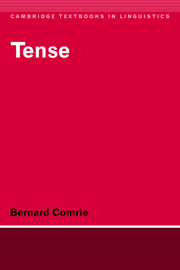5 - Tense and syntax
Published online by Cambridge University Press: 05 June 2012
Summary
At various points in the discussion so far, and especially in chapter 1, we have mentioned in passing that apparent exceptions to the use of a given tense as defined by its meaning can be accounted for in terms of the interaction of the meaning of that tense with independently justifiable syntactic rules of the language in question. To justify this position, of course, it is necessary to specify what these syntactic rules are, and to show how their interaction with the meanings of tenses does indeed give rise to the observed apparent anomalies in tense usage. In this chapter, we shall look in greater detail at some examples of this interaction, to illustrate the way in which such apparent anomalies should be handled within an integrated approach to the description of a language. The interplay between the semantics of tense and syntax in fact predicts that the observed apparent anomalies in tense usage should occur; if they did not, it would be necessary to revise the theory. That is why such anomalies are referred to as apparent anomalies: the independently justified meaning of a tense interacts with an independently justifiable syntactic principle in order to produce a use of the tense which, superficially, seems to contradict the meaning of that tense.
Tense neutralisation
In several languages, there is a rule whereby within what would otherwise be a sequence of like tenses within a sentence, only the first verb shows the expected tense, while all subsequent verbs are in a single tense category, irrespective of the tense of the first verb (and thus the time reference of the later verbs).
- Type
- Chapter
- Information
- Tense , pp. 102 - 121Publisher: Cambridge University PressPrint publication year: 1985



